Look Beyond Your State
When I was in high school, my parents told my sister and me that we could go to any college we wanted…as long as it was in our home state of Virginia.
When I attended the University of Virginia in 2004, the in-state total cost of attendance was about $12,000 per year (including tuition, fees, books, room and board). My sister graduated high school two years later, in 2006, and went to Virginia Tech, where it cost about $11,000 annually.
Fast forward the clock to the 2023-2024 school year:
An in-state education at UVA costs about $38,000 per year. Now multiply that by four years plus the projected annual cost increases, multiplied by the number of kids you have. Yikes! That is around $140,000+ over four years!
Other quality state schools within Virginia offer lower in-state rates. But what if these schools are not the best fit for your student? Or, what if you live in a state with fewer in-state options? Or, what if you can afford the higher cost of a prestigious in-state school, but you and your child are not confident they’ll get in?
We encourage parents and students to think outside the box if they want to find the right academic, cultural, and financial fit. This includes looking beyond your state borders. In-state is not necessarily the most affordable option anymore, especially if your student can qualify for merit aid out-of-state as a high performer.
If your child has an above-average GPA and SAT/ACT score compared to other students at the school, you often can receive generous merit aid and scholarships from both private colleges and out-of-state publics. Please remember that GPA numbers listed below are almost always the student’s core or “unweighted” GPA.
Many of these colleges do not get a lot of applicants from the East and West Coasts and are looking to diversify their student body further and improve their academic environment. In many cases, these universities are located towards the middle of the country and will be less expensive than the total cost of attendance for popular state colleges like UVA, VT, UMD, UNC, UT-Austin, UGA, and UFL (i.e., highly ranked public schools that get flooded with applications). This is because tuition and fees net of scholarships at the schools on this top 15 list can be very low, so parents pay primarily for room and board plus ancillary costs.
Many of these schools offer automatic scholarships—based on GPA and/or test scores–that are outlined on their respective websites. In this blog, I will provide 15 schools that can provide an affordable out-of-state education, along with their award charts and links to their scholarship pages. I have listed them alphabetically as I do not think ranking them makes much sense here.
Note: Several of the colleges listed offer generous scholarships to in-state residents as well.
(1) University of Alabama
Alabama is a great option for a student with a 3.5+ GPA and either a SAT 1200+ or ACT 25+. Its automatic merit scholarships range from $6,000/Yr. to $28,000/Yr.
Here’s its automatic merit chart:
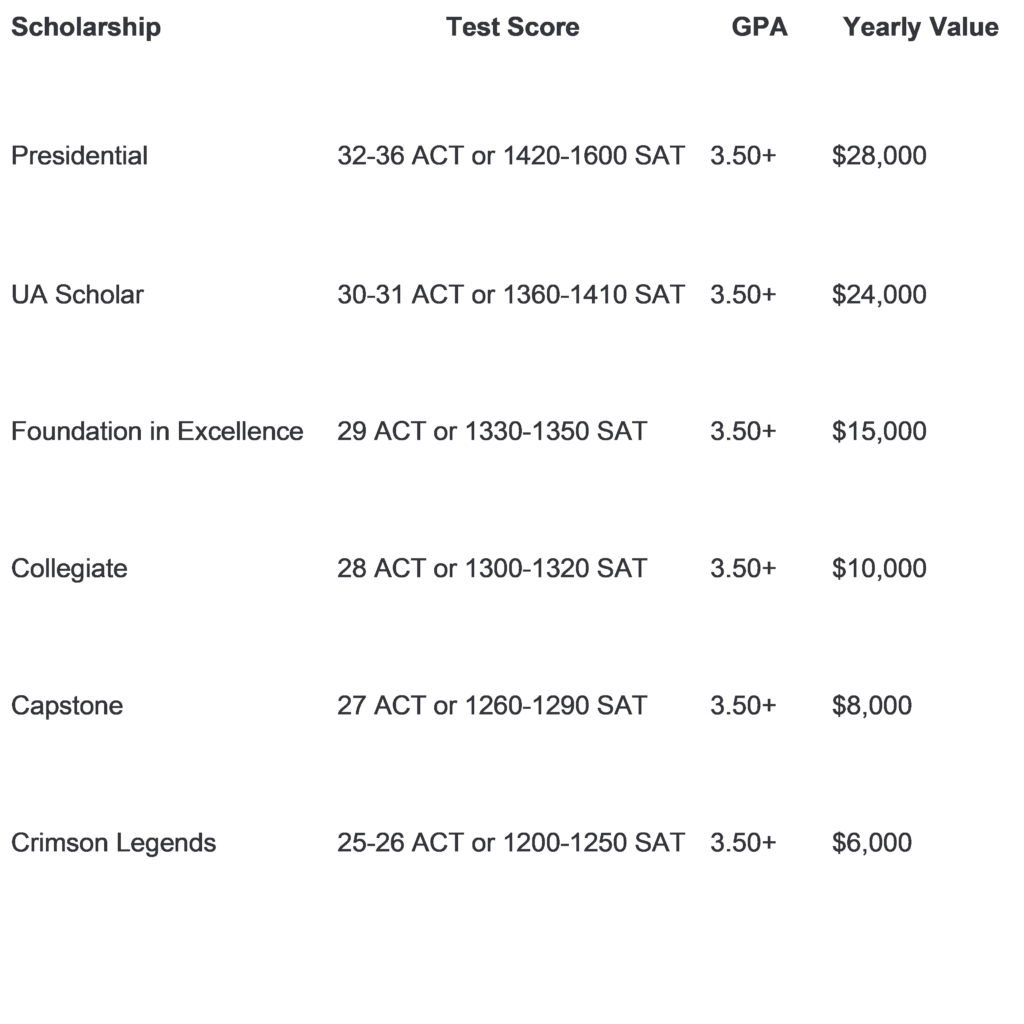
Source: https://afford.ua.edu/scholarships/out-of-state-freshman/.
Suppose your child qualifies for the highest automatic award: the Presential Scholarship. That means your total cost of attendance in Tuskaloosa is tuition minus the $28,000/Yr., plus room and board and ancillary costs. For the 2023-2024 school year, out-of-state tuition runs $32,400. Now, subtract the Presidential Scholarship of $28,000, and you only owe the delta of $4,400. Then, add room and board, fees, books, laptop, travel, etc., which is currently estimated at $19,580.
So, if you have an academically gifted kid, they could attend Alabama for only $23,980/Yr., ($4,400 + $19,580), which is significantly lower than the average in-state cost of attendance for the overwhelming majority of large public colleges
(2) University of Arizona
Arizona offers scholarships based on a sliding scale of the student’s core (i.e., unweighted) GPA through their sixth high school semester.
For example, if your child has a 3.75 GPA, he or she can receive $20,000/Yr. via the Excellence Award. Applicants with a 4.0 GPA are offered $32,000/Yr. courtesy of the Distinction Award.
Tuition and fees for non-resident incoming freshmen for 2023-2034 is $41,000/Yr.
Assuming the child qualified for the Excellence Award, the tuition and fees would drop to $21,000/Yr.
Add in room and board + additional costs, ($19,600/Yr.), so $40,600 total.
With a 4.0 core GPA, the total annual out-of-pocket cost would be $28,600 ($41,000 – $32,000 + $19,600).
Arizona is a good school to consider from out-of-state, especially for a student with a high GPA and no or low test scores
(3) University of Arkansas
The Razorbacks offer 90 “Endowed Fellowships” each year, paying up to $20,000 for students with at least a 32 ACT / 1430 SAT and a 3.90 GPA or higher. These scholarships require an additional application.
Tuition and fees for out-of-state students run $28,772/Yr. This would drop to $8,772 if your child were to qualify for one of the Endowed Fellowship scholarships. Add in room, board, and ancillary costs; you’re all in at $29,032 ($8,772 + $20,260).
What if you don’t win a fellowship?
The University of Arkansas also offers the New Arkansan Non-Resident Tuition Award Scholarship, which automatically offers a certain percentage of the difference in tuition for non-residents based on GPA. This award is more generous for bordering states, but if you’re from the East Coast and have a 3.6+ GPA, you can qualify for 80% off the difference in in-state and OOS tuition. That’s about a $15,000 discount, meaning your total cost of attendance would be $13,552 for tuition/fees + $13,290 for room & board + $6,970 for indirect costs, coming out to a total cost of $33,812.
The University of Arkansas offers several other large scholarships. It is unclear whether you can stack them or not (e.g., fellowship or chancellor’s scholarship + non-resident waiver). Make sure to call the admissions office to clarify which scholarships you can stack together.
Here is the University of Arkansas scholarships page: https://catalog.uark.edu/undergraduatecatalog/financialaidandscholarships/scholarshipsfornewstudents/.
(4) University of Kentucky
At Kentucky, I have already seen a couple of students from families I work with get awarded freshmen out-of-state merit scholarships for the 2024-2025 school year.
Non-resident tuition and fees for the upcoming school year are $33,406. If your student qualifies for the $12,500/Yr. Bluegrass Academic Scholarship, the net tuition cost would run you $20,906 plus room, board, and other costs. Currently, room & board costs $15,242/Yr. So, your cost all-in would be $36,148 + indirect costs. The Wildcats outline the automatic awards for nonresidents below:
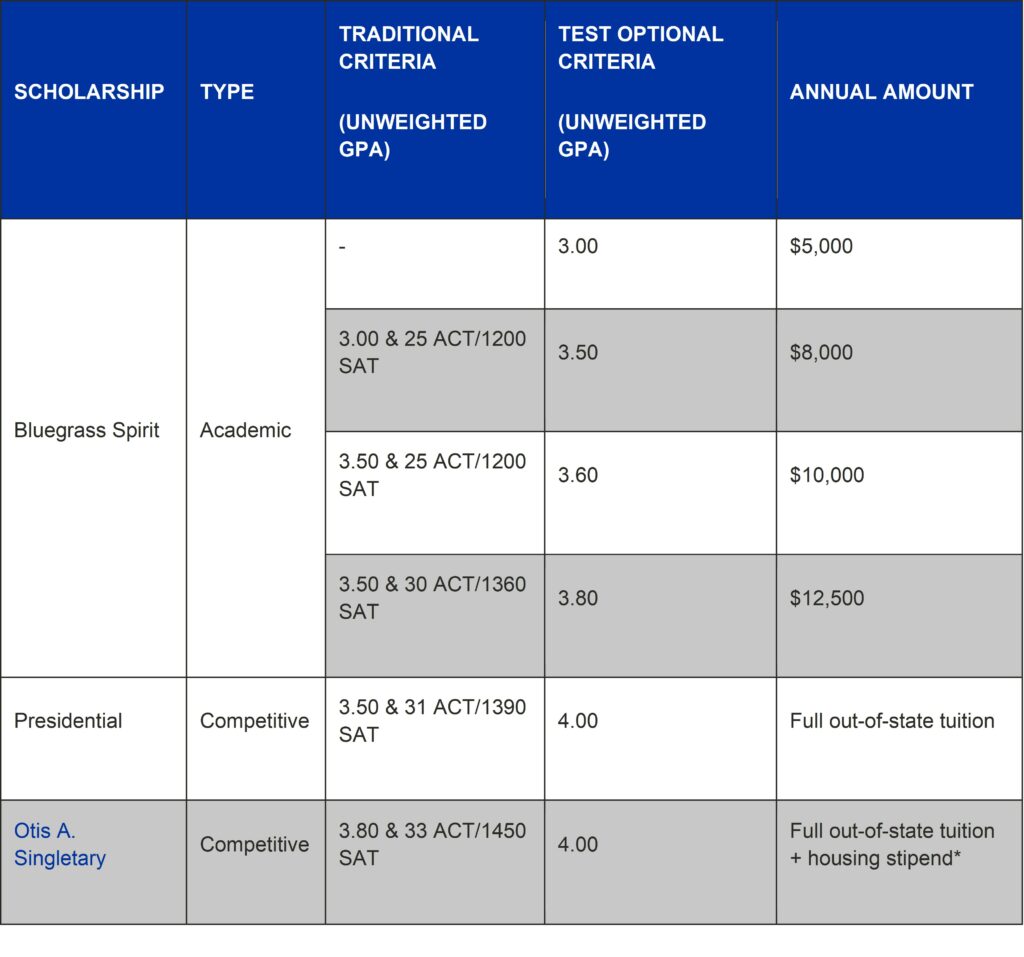
Source: https://www.uky.edu/financialaid/scholarship-incoming-freshmen
Note: The Presidential and Singletary Scholarships are competitive scholarships that require a separate application. The University of Kentucky received over 2,600 competitive scholarship applications for the 2023-24 incoming freshman class and awarded 50 Presidential scholarships and 25 Otis A. Singletary scholarships.
(5) LSU
Unlike many of the schools on this, Louisiana State University does not list a specific SAT/ACT and GPA chart.
However, they are well known for generous scholarships for non-resident applicants. I have seen many families over my 15-year career send their academically gifted kids to Baton Rouge on a merit scholarship where tuition and fees were 100% covered, or close enough so that the total cost of attendance was similar to an in-state average.
According to the Tiger’s website, 95% of students receive some form of scholarships or financial aid. The top two merit awards are the Stamps and President’s Alumni Scholarship, which cover the full tuition and fees over four years.
In addition, there are other potential costs covered, such as housing and study abroad programs, based on other factors: https://www.lsu.edu/financialaid/types_of_scholarships/entering_freshman_scholarships/top-merit-based-scholarships.php
(6) Louisiana Tech
Like many schools on this list, Louisiana Tech offers automatic merit scholarships for incoming freshmen listed on their website.
Tech’s main out-of-state scholarship is called the “Bulldog Scholarship.” It waives the out-of-state tuition premium and fees.
The scholarship varies depending on where you live. Admitted Arkansas, Mississippi, or Texas students automatically receive the Bulldog Out-of-State Scholarship.
Students who are NOT from the states listed above must have the following stats to qualify:
– ACT 23 or SAT 1130
– 2.5 GPA
– Do not need remedial Math or English courses. Must meet the minimum threshold for ACT English or SAT Writing/Language.
For more info, check out the scholarship page here: https://www.latech.edu/admissions/freshman-scholarships/.
(7) University of Louisville
The Cardinals have some great options available for incoming freshmen from out of state. There are regional differences, as you can see below:
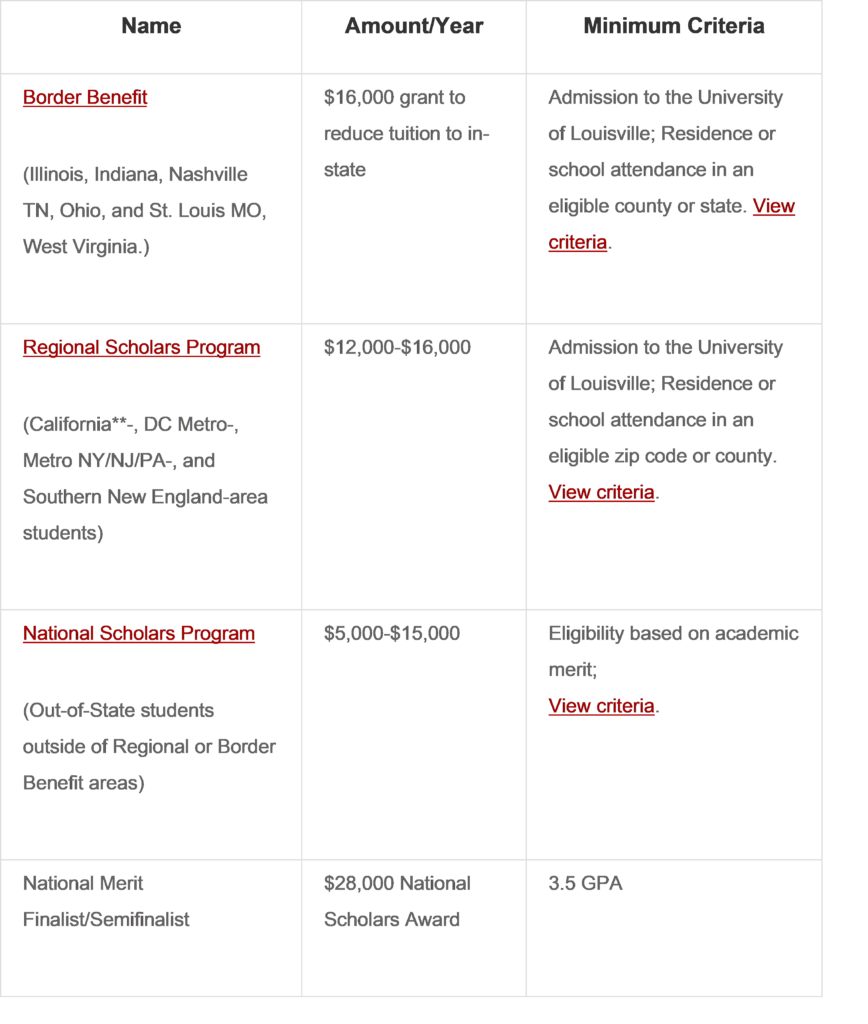
Source: https://louisville.edu/admissions/cost-aid/scholarships/out-of-state-scholarships
Let’s say you receive the full Regional Scholarship at $16,000 per year. The direct cost of attendance at Louisville for nonresidents is $42,044. This means you would pay only $26,044 for the first year (plus miscellaneous costs like transportation).
In addition, Louisville offers competitive, mentor-based scholarships for those interested in undergraduate research. The Grawemeyer Scholarship provides $28,000 to qualifying candidates who demonstrate an interest in faculty-supervised research, submit an application with their own background and research ideas, and have a 3.5 GPA or higher.
(8) University of Mississippi (Ole Miss)
At the University of Mississippi, some very generous scholarships are available for high-performing students. Below is the 2023-2024 academic merit scholarship chart:
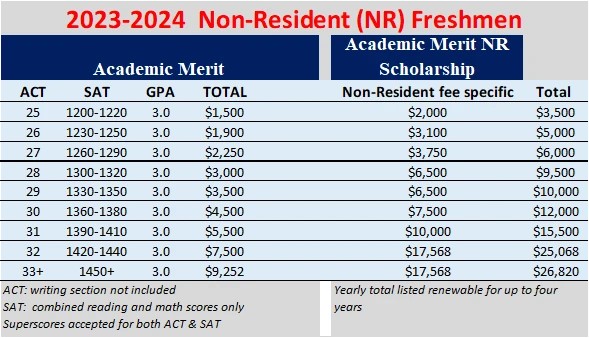
Ole Miss also provides a ton of other scholarships, including awards for National Merit Finalists and even a need-based Red & Blue scholarship for which nonresidents can qualify. Check out the full list here: https://finaid.olemiss.edu/scholarships/.
(9) University of Missouri
Mizzou is another college that lists its SAT/ACT and GPA requirements for out-of-state scholarships (see below):
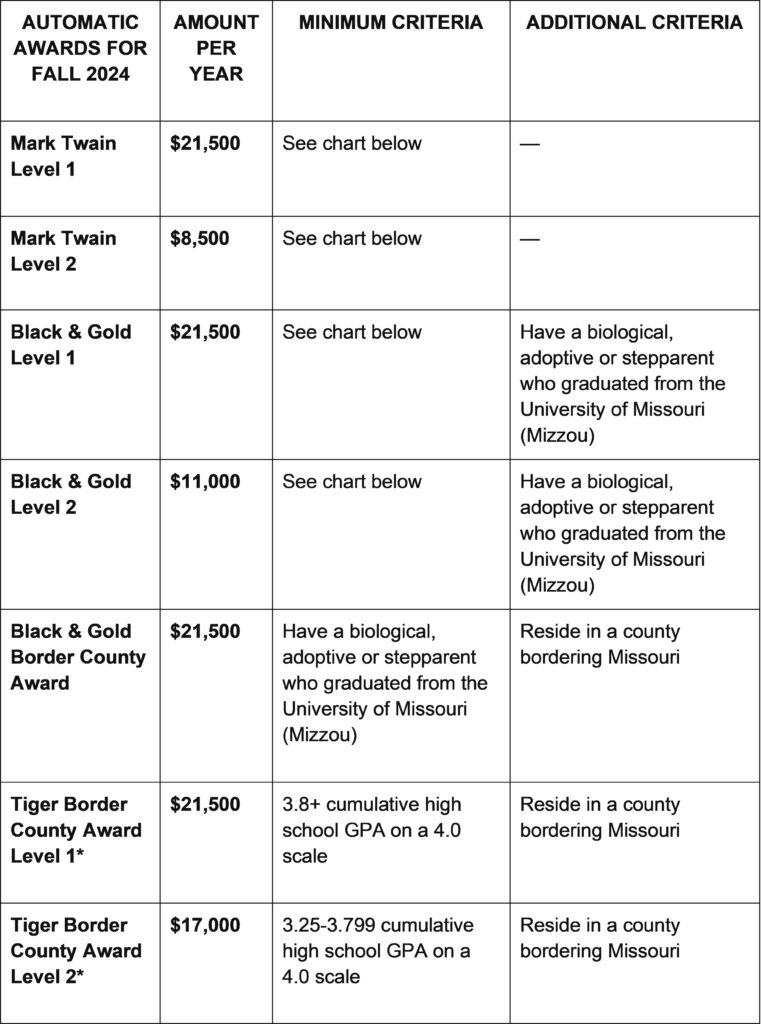
Here are the criteria for the Mark Twain Award:
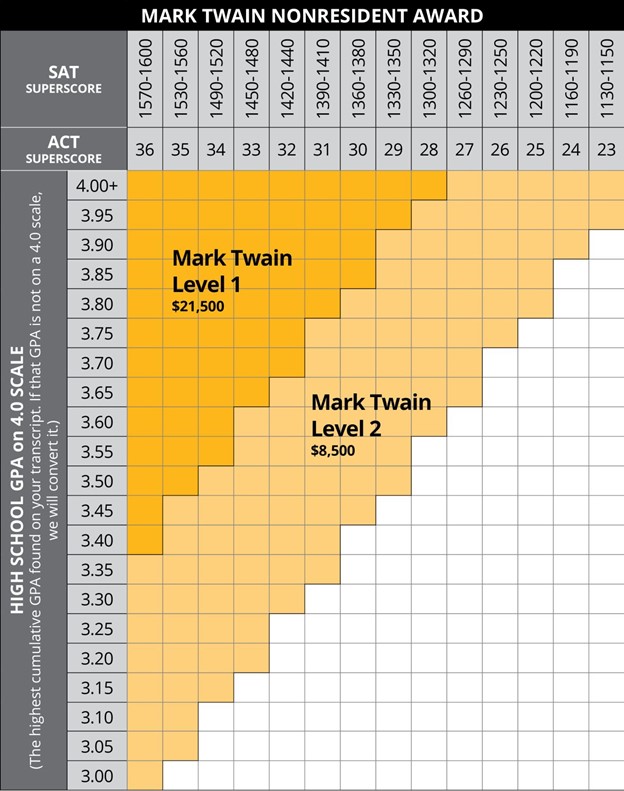 Source: https://admissions.missouri.edu/costs-aid/scholarships/freshman-scholarships/
Source: https://admissions.missouri.edu/costs-aid/scholarships/freshman-scholarships/
(10) University of Oklahoma
The University of Oklahoma offers generous scholarships for National Merit Finalists and Semi-Finalists. Tuition and fees are covered 100% for Finalists. That’s ~$130,000 saved if your student qualifies.
For National Merit Semi-Finalists, the Sooners will offer $16,000/Yr. in scholarships, assuming the student has a 3.5+ core GPA.
In addition, the Sooners offer the same scholarship of $16,000/Yr. if the student has 31+ ACT or 1390+ SAT, and 3.5+ GPA or top 10% class rank. The total cost of attendance out of state for Oklahoma is $53,482 (includes indirect costs). This means you could attend the University of Oklahoma for $37,482 per year all-in.
Other scholarships are available on the OK site for lower ACT/SAT scores at reduced amounts. For example, the Academic Achievement scholarship is $10,000/Yr. ($40,000 total) and only requires a 26+ ACT or 1230+ SAT, and 3.5+ GPA or top 10% class rank. Even these scholarships can put a sizeable dent in the cost of attendance.
(11) University of Tennessee
UT-Knoxville offers two types of automatic merit aid to nonresident students: the Explorer Scholarship and the Volunteer Scholarship.
Here is the chart for the Explorer Scholarship:
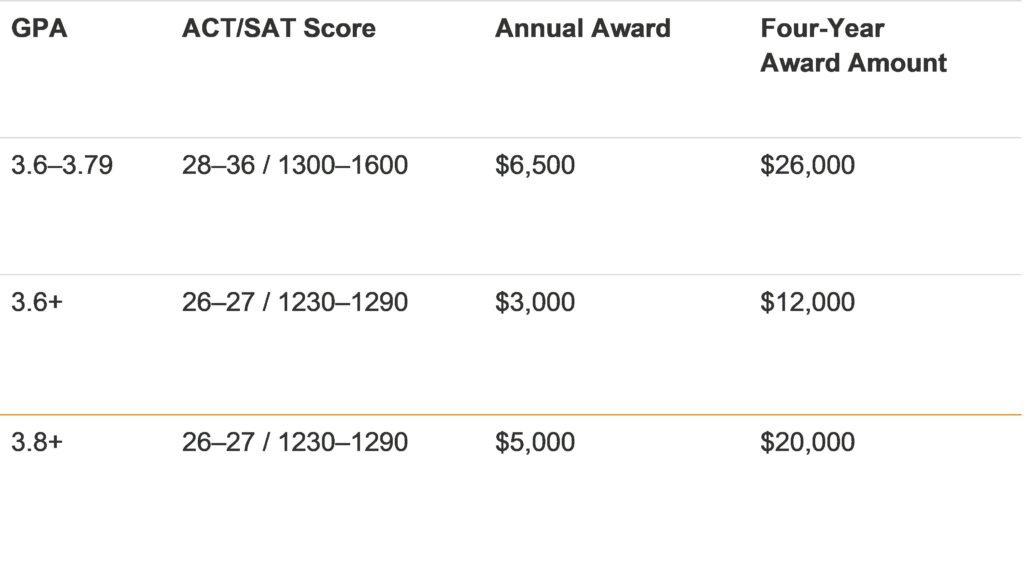
And here’s the chart for the Volunteer Scholarship:
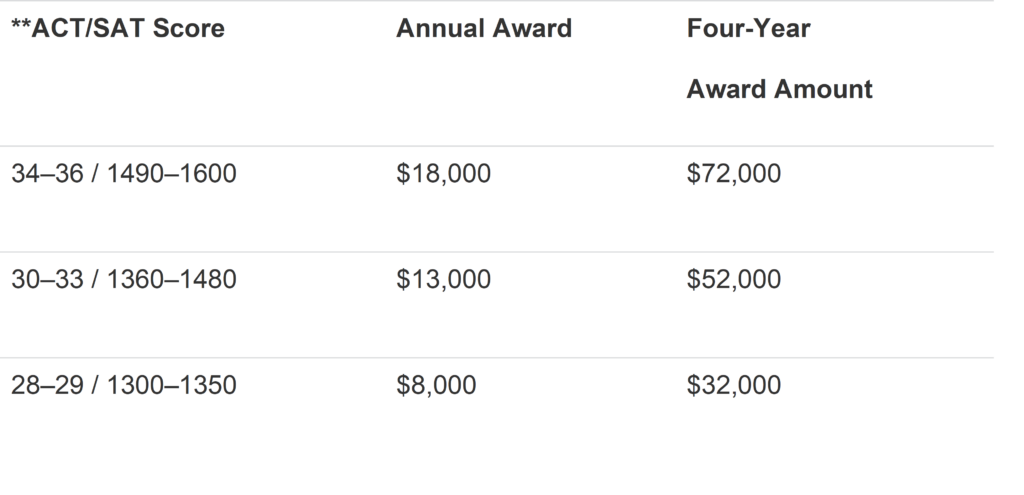
Unfortunately, students cannot receive both scholarships. It’s one or the other. Regardless, TN is another college with a reputation for providing generous scholarships to high-performing non-resident applicants. Also, housing costs in Knoxville are lower than the national average, so kids receiving awards can make TN a very affordable option.
Tennessee estimates that your total cost all-in for 2023-2024 (including indirect costs like personal and transportation) is $52,400. Let’s say your child can get the $13,000 annual award via the Volunteer Scholarship. That brings your net cost estimate to $39,400. Consider also that you could budget more efficiently than the UT estimate AND find cheaper housing after the first year.
UT-Knoxville Scholarship Page: https://onestop.utk.edu/scholarships/first-year/.
(12) Texas Tech
The Red Raiders also have a chart listed on their website revealing their merit qualifications:

Unlike many of the other schools on this list, you may notice that TX Tech posts a “Test Optional” row above. So, if a student has a high GPA but lower scores or no scores submitted, he or she can still get an automatic award.
I see many students with 1100-1290 SATs or 22-27 ACTs refrain from submitting standardized scores with their applications. Texas Tech is a good example of why they should reconsider that strategy. For example, a student with a 3.86 GPA and a 1200 SAT or 25 ACT, would receive $5,000/Yr. for submitting their scores instead of $3,000/Yr if they did not submit. That’s $8,000 in savings over four years just by submitting that score.
Texas Tech estimates a nonresident first year’s total cost to be $41,124. Let’s say you qualify for a merit award of $4,000/yr. As stated by Tech’s website, “If you are a non-resident awarded a Presidential Scholarship, you will also qualify to pay in-state tuition.”
With in-state tuition and another $4,000 off, you are now paying somewhere in the realm of $25,000.
(13) Utah State
The home of the “Big Blue,” Utah State, can help cover most of the out-of-state tuition premium. Also, note that they encourage students to become residents after one year at the school, particularly for the Deans Scholarship.
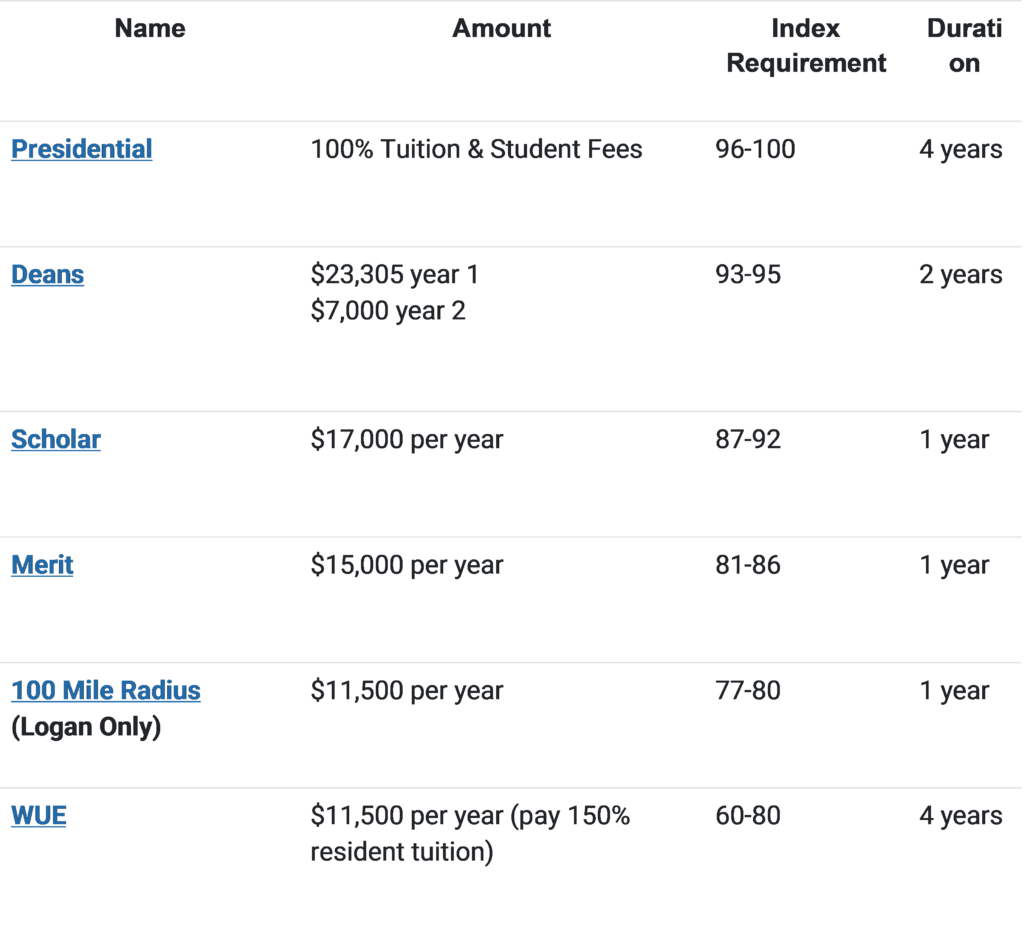
At $38,740, Utah State’s nonresident cost of attendance is relatively low compared to other big state schools. Take anywhere from $7,000 to $15,000 off that and you’ve got a great deal!
Note: Nonresidents are strongly encouraged to gain Utah Residency after their first year.
Here is a link to their website regarding these details: https://www.usu.edu/admissions/costs-and-aid/#scholarships.
(14) University of Vermont
For non-resident students looking to maximize scholarships, Vermont has a good reputation for offering generous awards.
Students who are out-of-state residents can qualify for one of two automatic merit awards:
1. The Presidential Scholarship, which ranges from $17,000 – $25,000/Yr.
2. The Trustee Scholarship, which covers $12,000-$14,000/Yr.
Neither academic award requires an additional application.
Unlike other universities that list GPA and SAT/ACT qualifications, Vermont offers awards based on the pool of applicants that school year. In other words, merit funds are granted on a curve. The top performing applicants will receive $25,000/Yr. and other students will get offered lower amounts based on their scores.
Let’s assume a student is awarded the lower amount of $17,000/Yr. for the Presidential Scholarship. That means families would be out of pocket $44,442/Yr. (estimated COA of $61,442 – $17,000 scholarship).
(15) University of Wyoming
Wyoming is another state university that outlines its automatic merit tiers for nonresidents on the school website.
These are called the “Brown and Gold” Commitment Scholarships, and they are available with and without submitted SAT/ACT scores. Depending on where the student falls on their academic award chart, it may still be worth submitting the test score. See the chart below for the detailed breakdown:
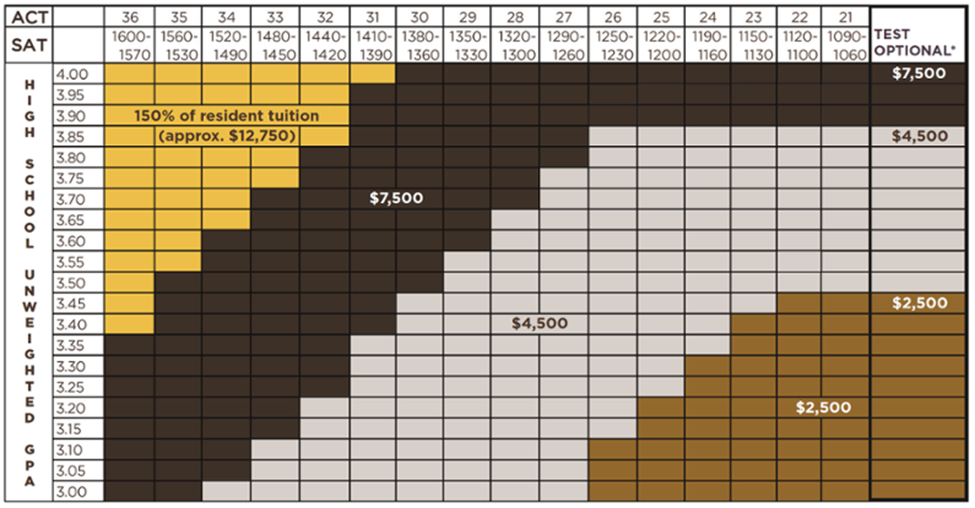
Source: https://www.uwyo.edu/sfa/scholarships/_files/docs/brown-gold-commitment-grid.pdf
The total estimated cost of attendance for a first-year nonresident at Wyoming is 43,098.
If your student qualifies for the $7,500 merit award, that comes to an out-of-pocket cost of $35,598 (this includes all indirect costs).
Final Thoughts
In summary, parents and students need to consider each school’s award system to ensure they are maximizing scholarships. Submitting a lower SAT/ACT score at certain schools may be beneficial versus simply going Test Optional. At other institutions, the child may be better off by not submitting their SAT/ACT scores.
Since college costs have dramatically outpaced inflation in the past couple of decades, it is more important than ever for parents to find the right fit for their children both academically and financially. These are the types of public schools where you can expect manageable costs. The days of an in-state education always being the most affordable option are all but gone. Most of the scholarships discussed on this list are automatic – meaning you do not have to submit a separate application. Please make sure you explore the scholarships and grants that require separate applications for each school as well. The best place to start is on their respective website.
Best of luck to all the incoming freshman applicants for the 2024-2025 school year! As a reminder to parents with high school seniors, the FAFSA (Free Application for Federal Student Aid) will become available on December 31, 2023. At a minimum, it is wise to complete the FAFSA to qualify for Federal Direct loans that everyone gets offered, even families with high income and assets.
Feel free to email me at tmcfillin@thecollegefundingcoach.org with any questions.
Thank you!
Author:
Further Reading:
My Kid Is a Decent Student but We Will Not Qualify for Need-Based Financial Aid

